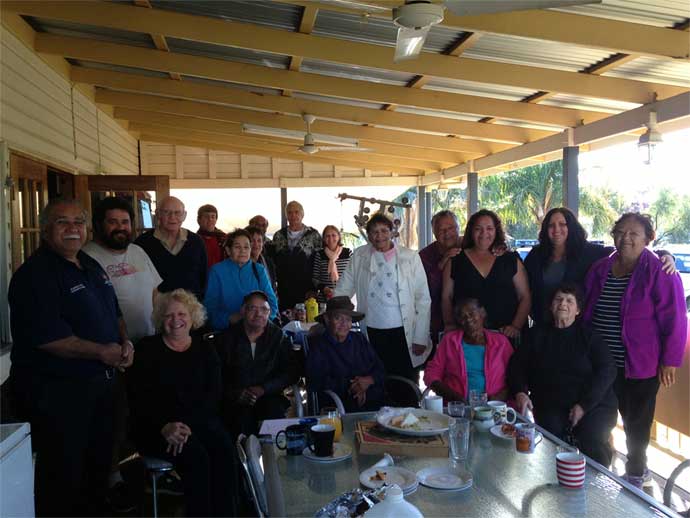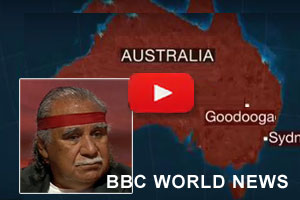Euahlayi Nation declares independence and asserts pre-existing and continuing Statehood

Euahlayi Flag of Statehood (Draft copy)
The Euahlayi Nation (Pronounced you-al-ee-eye)
12 August 2013
Goodooga, Euahlayi Nation, in upper western region of NSW
Ghillar, Michael Anderson, Convenor of the Sovereign Union and now Convenor of the Provisional Euahlayi Peoples Executive Council said today:
On 3 August 2013 in Dirranbandi, Queensland, a meeting of key Euahlayi family members and Elders concluded that a letter be forwarded to Her Majesty Queen Elizabeth II, informing her that the People of the Euahlayi have asserted their pre-existing and continuing Statehood.
This decision follows on from previous correspondence with Buckingham Palace. On 24 July 2010 I wrote under my natural and given Euahlayi name, Ghillar, to Her Majesty Queen Elizabeth II asking the following questions:
- Can you provide us with the documents, where war was declared against the Peoples of the Euahlayi Nation or where
- The Peoples of the Euahlayi voluntarily ceded their sovereignty to Great Britain.
Our most recent correspondence reminds Her Majesty that on 24 August 2010 her Senior Correspondence Officer, Mrs Sonia Bonici, wrote from Buckingham Palace that:
As a constitutional Sovereign, Her Majesty acts through her personal representative, the Governor-General, on the advice of her Australian Ministers and it is to them that your appeal should be directed.
I also received a letter addressed to ‘Ghillar’ from the Office of the Official Secretary to the Governor-General signed by Mark Fraser OAM, Deputy Official Secretary to the Governor-General, responding for and on behalf of Queen Elizabeth II’s, Australian representative saying that:
I regret to advice you that I cannot add anything further to my reply of 7th July and I am unable to supply any of the documents that you seek.
Clearly, the Heads of Government within Australia are unable to produce any legitimate documents, which provide a legal right for their continuing governance over our lands and waters within our borders.

Enlarge image
Provisional Euahlayi Peoples Executive Council and the Senior Council of Euahlayi Elders
Dirranbandi, Qld, on 3 August 2013
Left to Right - Standing Frontline: Ghillar (Michael Anderson) [Executive Council]; Jason Dries [Executive Council]; Lindsay Noble (Elder); Lyla Dries (Elder); Mavis Eckford (Elder); Margaret Crump. Dr. Mayrah Dries (executive Council); Lenese Cooper (Elder)
Back Row: Jason Dries Jnr; Gordon Weatherall (Executive Council); Neville Anderson; Pam Touma (Executive Council) and Edgar Draper.
We can understand Australia’s fears when we assert our sovereignty. In Mabo [2] 1992 the High Court of Australia said that the issue of continuing Aboriginal sovereignty, is a question, that belongs to another jurisdiction and cannot be dealt with by any municipal courts. (That is, local Australian courts including the High Court of Australia). According to Justice Brennan in the High Court Mabo No.2 judgment:
Moreover, the Mabo [2] judgment expressed grave concerns since, recognising a continuing propriety interest in land under Aboriginal law and custom, creates some serious legal dilemmas.
This is evident in their judgment at paragraph 43, where, the judges show in many ways, concern, that Australia’s claim to sovereignty over Aboriginal people and their land is compromised.
The judgment shows extreme concern when they say at paragraph 44 that:
The Euahlayi Declaration of Independence asserts that we are the First Nation State to occupy our lands and waters, governed by our Law and customs. If the Australian State has a legal and political problem in respect to their sovereignty and governance because of our declaration of Statehood, then it is their right to negotiate with us about the future of their role within our borders. In other words, if they want a relationship with us they need to negotiate with us.
The fact that the Commonwealth government is proposing a referendum to include Aboriginal and Torres Strait Islanders in their racist Constitution from Britain affirms our pre-existing continuing statehood. We have always asserted that our sovereignty has never been ceded to the colonising power. Australia’s relationship with the British Crown and Australia’s future as a nation is for them to sort out.
A complementary authority for our action comes from the American Declaration of Independence. During the imperial expansion of the European nations Great Britain lost a civil war on the American mainland to George Washington and his supporters from the then existing thirteen American colonial states. Representatives of these thirteen states, including such famous men as George Washington, George Adams and Thomas Jefferson (all of whom were later to become Presidents in their own right) were among those who signed the American Declaration of Independence.
American Statehood was later confirmed in their Supreme Court in the case Underhill - v - Hernanadez , 168 U.S. 250 (1897). This case established a legal principle, which is now accepted in the international community as a legal international doctrine which concludes:
This is often viewed by First Nations Peoples as being a non-acceptable principle based on colonialism. Nevertheless, First Nations Peoples in America have had their independent sovereignties recognised and are treated sovereignty to sovereignty with many First Nations in the process of becoming economically independent. On 9 July 2013 the American Ambassador affirmed this during a public discussion in the Great Hall of Parliament House, Canberra, with Prof George Williams on the Australian Constitution Day, appropriately named ‘AusCon Day’. The discussion was livestreamed by the ABC Big Ideas programme.
We also know that for a long time the Commonwealth Government has been very worried about the right of First Nations to assert their sovereignties and want to avoid the American model at all costs. On 3 March 1981 Minister for Aboriginal Affairs, Peter Baume advised:
I note that the resolution by the NAC requests a treaty of commitment between the Australian government and the ‘Aboriginal nation’. For the reasons mentioned above the use of that word should be avoided by the Commonwealth.
The Euahlayi Declaration of Statehood and the formation of the Euahlayi provisional executive council of parliament appropriately preceded the International Day of the World’s Indigenous Peoples, 9 August 2013, which had as this year’s theme:
The theme aims to highlight the importance of honouring arrangements between States, their citizens and indigenous peoples that were designed to recognize indigenous peoples' rights to their lands and establish a framework for living in proximity and entering into economic relationships.
Agreements also outline a political vision of different sovereign peoples living together on the same land, according to the principles of friendship, cooperation and peace.
Convenor Euahlayi Nation Executive Council and Sovereign Union
ghillar29@gmail.com
www.sovereignunion.mobi


